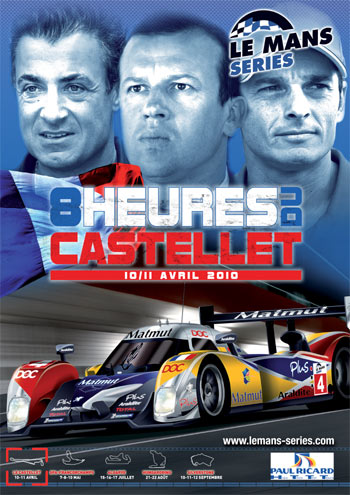 A
Fresh beginning for RML AD Group
A
Fresh beginning for RML AD Group
After
the disappointment of 2009, Mike Newton and
Thomas Erdos are looking forward to starting
a fresh slate in 2010. The familiar and reliable
Lola chassis has now been united with an engine
that, in reputation at least, matches the
coupé's character, and testing in early
March lived up to expectations. Both drivers,
now joined for the year by Andy Wallace, are
looking forward to a more rewarding season.
2010
kicks off with a new venue for the Le Mans
Series, and an extended race length as well.
The 8 Hours of Paul Ricard should be the perfect
beginning, and also an excellent precursor
to Spa and the Le Mans 24 Hours which follow.
The circuit, however, is something of an enigma.
Almost every motorsport enthusiast will have
heard of Paul Ricard, and many will instantly
recognise any photograph taken there, but
few will know where it is, and only a small
handful will have ever actually been there.
A
History of Paul Ricard HTTT
For
many years, between 1999 and 2009, the circuit
was the exclusive domain of the Formula 1
teams, who were invited to use the circuit’s
flexible layout configurations to mimic many
of the world’s leading Grand Prix circuits,
and thereby carry out intensive testing and
preparation work. Changes in the regulations
two years ago resulted in the banning of mid-season
F1 testing, and with that, the raison
d’etre for the Paul Ricard track
diminished. But the preceding decade of intensive,
secretive testing, had seen many hundreds
of thousands of pounds invested in the circuit
by the track’s owners, a company called
Excelis, owned by Bernie Ecclestone and managed
by Frenchman Philippe Gurdjian.
Monsieur
Gurdjian’s association with the Paul
Ricard circuit pre-dates the involvement of
the Ecclestone empire, and reaches back almost
as far as the track’s conception in
the late 1960s. As the name suggests, the
circuit has close ties with the anise-based
liqueurs that remain so universally popular
in France. Paul Ricard, a member of the company’s
original founding family, had a passion for
motorsport, and wanted to build his own circuit,
ostensibly to carry out some private research
into road construction. He was mildly eccentric,
as well as an astute businessman.
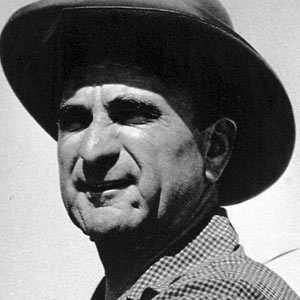 Paul
Ricard, the Man
Paul
Ricard, the Man
Born
in 1909 in a rural suburb of Marseilles, not
far from the site of today’s circuit,
Paul was still only in his teens when he devised
the liqueur that would ultimately become world
famous as Ricard. Pastis-type drinks had been
around for years, of course, but had become
notoriously ill-refined and dangerous, to
the point that they were banned in 1915 for
fear that the effects might undermine the
“war effort”. So Paul Ricard carried
out his experiments in secret, and tested
his concoctions on friends and in illicit
bars in the back-streets of Marseilles. When
the ban was lifted in 1932, Ricard launched
his perfected drink to instant acclaim. It
soon became the best-selling pastis in France.
In
many respects, Ricard was way ahead of his
time and he was wise to the attraction of
sport as a medium for promoting his products.
He became a major sponsor of the Tour de France,
long before sports sponsorship became the
norm, and the “yellow jersey”
worn by the leading rider in the Tour suited
his strategy perfectly. It is conspicuously
the same yellow as the Ricard brand’s
dominant colour. Paul also looked to two of
his life’s other passions as avenues
for his marketing strategy – yacht racing
and motorsport.
The
track that bears his name was completed in
1969, and was built almost within sight of
his birthplace. Without the constraints of
being based on an old airfield (and right
from the start, the new circuit had its own
airstrip) or having to follow a modified street
layout, as so many other race tracks of the
period were required to do, Paul Ricard’s
new facility was immediately seen as strikingly
modern and one of the safest racing circuits
in the world.
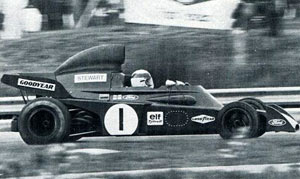 French Grand
Prix
French Grand
Prix
As
he had hoped, Paul’s innovative track
was soon adopted as the home for the French
Grand Prix, with Jackie Stewart winning the
inaugural event at Paul Ricard in 1971. Through
the 1970s the French Grand Prix tended to
alternate between Paul Ricard and other national
circuits, including Dijon, but during the
1980s all but two of the Grand Prix were staged
there. The last, in 1990, was won by Alain
Prost for Williams.
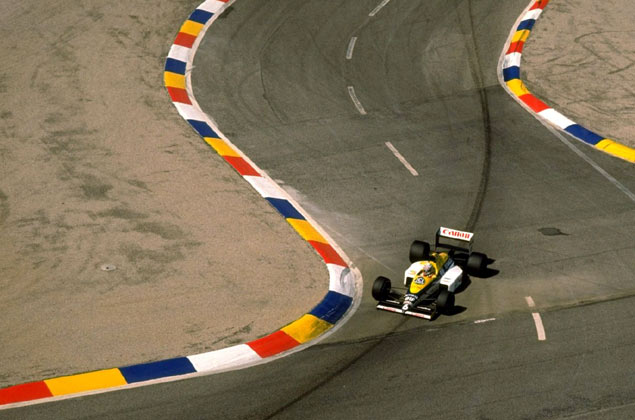
The
End of an Era
Although
Elio de Angelis had been killed in a testing
accident at Paul Ricard in 1986, and his death
is often cited as a reason for the decision
to move the French Grand Prix permanently
to Magny Cours, the truth is probably more
deeply embedded in French politics. The President
of the time, François Mitterand, was
a native of Nevers, just down the road from
the Magny Cours circuit. He was a personal
friend of Guy Ligier, owner of one of the
prevalent F1 teams of the period, which was
based there, and Pierre Beregovoy, French
Finance Minister, was also Mayor of Nevers.
Some 250 million francs were spent on upgrading
Magny Cours, and from 1991 until 2008, that’s
where the French Grand Prix was held.
The
layout at Paul Ricard was modified to address
the safety issues. The Mistral straight was
shortened and the first corner where de Angelis
had died was re-profiled to slow it down,
but denied its major role the track fell into
decline. For nearly a decade the circuit was
reduced to hosting club, motorcycle events
and truck races. Paul Ricard himself had retired
from his drinks business, handing over the
reins to his son, and settled in Signes, just
to the north-east of the track, where he became
Mayor. He died in November 1997.
A
New Beginning
Following
Paul Ricard’s death the circuit was
sold to Excelis, and the new owners embarked
on a radical rebuilding programme under the
guidance of Philippe Gurdjian. The intention
was that Paul Ricard would become the epitome
of the perfect F1 circuit. All the latest
design ideas were incorporated, including
a high-tech surveillance system that effectively
relieves the trackside marshals of all but
their emergency response duties. Thirty-eight
traffic lights largely replace the old-fashioned
flag waving, and a central control room (below)
monitors every inch of the track using a vast
array of cctv monitors. Cars are tracked electronically
using on-board transponders, and timing screens
can display their exact position on the circuit
at any time. These transponders also trigger
the warning light systems automatically if
a car goes off the track.
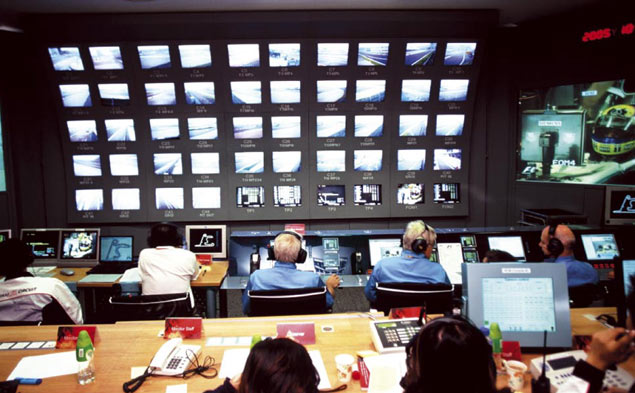
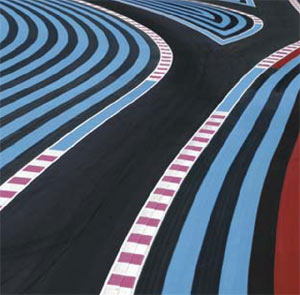 Most
conspicuously, Paul Ricard does not have the
usual gravel traps to collect cars that run
wide, lose control, or are involved in accidents.
Instead, the racing tarmac is flanked by 25
hectares of asphalt run-off carrying distinctive
bands of colour in red, blue and white. Each
band represents a change in abrasive qualities.
Most
conspicuously, Paul Ricard does not have the
usual gravel traps to collect cars that run
wide, lose control, or are involved in accidents.
Instead, the racing tarmac is flanked by 25
hectares of asphalt run-off carrying distinctive
bands of colour in red, blue and white. Each
band represents a change in abrasive qualities.
The
dark asphalt is fairly conventional, but the
blue bands incorporate an amalgam of tungsten
to increase the “stopping power”,
while the red bands are even more abrasive
– so much so, that a car crossing these
with its wheels locked will certainly need
a new set of tyres. Elsewhere, pale-coloured
run off is only mildly more abrasive than
the track, and replaces the grass areas seen
on regular race circuits. Right at the limit
of likely excursions, the track is bordered
by TecPro crushable polyethelene blocks that
replace traditional tyrewalls. This type of
run-off system increases safety, reduces the
intervention time of the rescue teams, reduces
damage to the car, and was just one of many
factors that earned Paul Ricard the first
FIA Institute Centre of Excellence
award in 2007.
Since
2009 in-season testing has been banned in
Formula 1 (although is under review at the
moment) and this change in the regulations
meant less need for a dedicated test track
like Paul Ricard. As a result, proper racing
has returned to the circuit, with the FIA
GT Championship being a major attraction in
2009. This season the opening round of the
2010 Le Mans Series is the big feature, and
a large crowd is hoped for, although they’ll
have few places to go. The spectator enclosures
are restricted to the final sequence of corners
and along the start straight, where a modest
grandstand overlooks the pits, which all contributes
to a capacity limit of just 4,000. Fortunately,
it is one of the better areas to view, and
with generous banking and the new Grand Prix
Hall at its heart, should meet with approval.
So,
what is it like to race at Paul Ricard? We
asked RML’s new signing for 2010, Andy
Wallace, to take us on a tour of the track
. . . .
A
lap of Paul Ricard with Andy Wallace
We
join Andy as he accelerates out of the final
corner and begins a fresh lap of the circuit.
All italicised sections in "inverted
commas" are Andy's words. With acknowledgement
to Google
Maps for the overhead images of the circuit.
“The
lap begins as you cross the start/finish line
on the Pit Straight. It’s wide, there
are rows of team pit boards on the right,
and you’re “plucking” gears
under full acceleration on the run down to
the first corner at la Verrerie.”
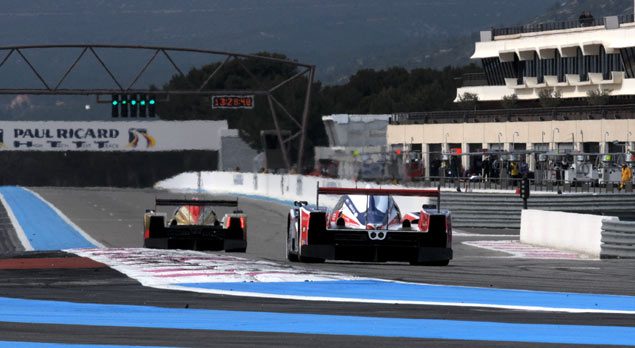
This
is the site of the original corner where de
Angelis suffered his fatal accident in 1986,
but the track is much changed since then.
The characteristically generous Paul Ricard
run-off offers plenty of forgiveness to anyone
mistaking their approach – and many
do.
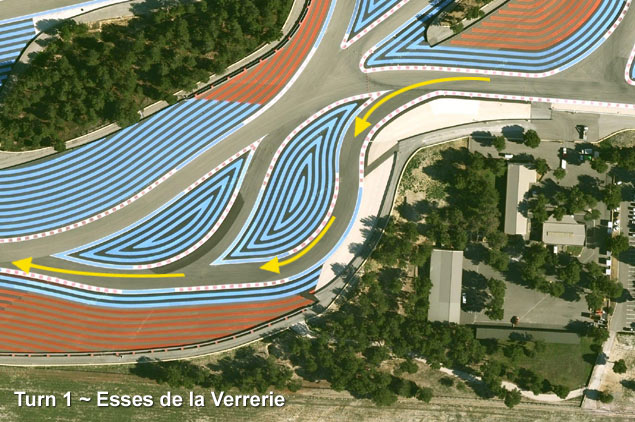
“Arriving
at full revs in fifth, you line up towards
the right-hand side of the track ready for
the braking area. You need to watch out for
cars exiting the pits, then it’s hard
on the brakes and down into second gear for
the left-right complex. La Verrerie is very
tight but the entry is slightly faster than
it looks as you approach. Around the first
apex the road rises towards the second apex
on the right before falling away again on
the exit. It’s easy to run out of road
here if you get onto the throttle too early.”
The
circuit plan illustrates how the organisers
have more than 170 options on track layout
at Paul Ricard, and Le Verrerie is one of
several corners where there are numerous alternative
routes. On the whole, the Le Mans Series racing
line follows the longest route, around the
outer limits of the track.
“Next
comes a short blast down towards “Chicane”
(below)."
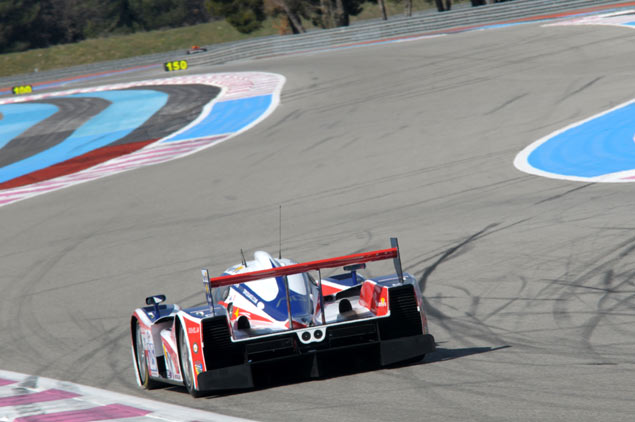
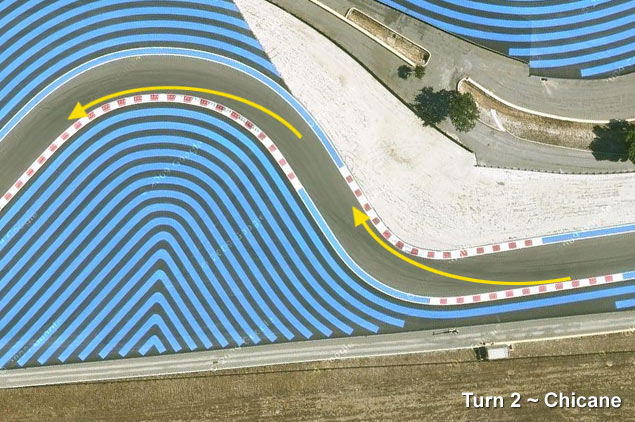
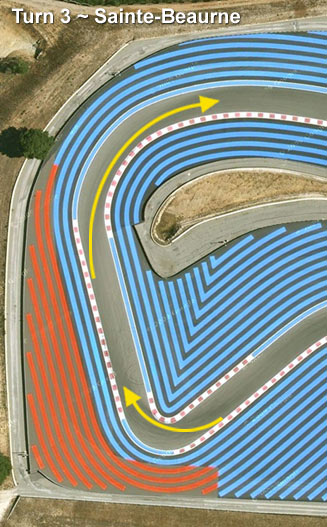 "As
you approach the corner the track curves gently
to the left before you brake hard again for
the right, which is taken in second gear.
Immediately the tight left appears, and you
have to get the car slowed and down into first
gear (see above). Then you momentarily
go to full throttle in first before braking
again for the right hander at Sainte-Beaurne.”
"As
you approach the corner the track curves gently
to the left before you brake hard again for
the right, which is taken in second gear.
Immediately the tight left appears, and you
have to get the car slowed and down into first
gear (see above). Then you momentarily
go to full throttle in first before braking
again for the right hander at Sainte-Beaurne.”
This
is the farthest extent of the track, over
a kilometre from the spectator enclosures,
and out of sight of anyone except accredited
photographers, marshals, and those watching
the TV monitors. There’s a very short
straight separating the two elements of the
Sainte-Beaurne corner, illustrated on the
left, rather like Luffield at Silverstone.
A
solitary tree overlooking the final element
gives the drivers a reference point to work
with in this important corner, since it's
from here that they'll begin the slingshot
that sends them out onto the Mistral. Get
this right, and they can begin to unleash
their car’s power for the long run up
the back straight.
“Back
to full throttle and up through second and
third gears. You have to lift slightly as
the car washes wide in the long right hander
of the Esses (left, top), then flat
out through L’Ecole (diagram below),
grabbing fourth on the exit."
"Way
ahead, up the long Mistral Straight, is the
ultra fast Signes corner, but for now it's
all about building up speed. Up through fifth
to sixth gear, accelerating all the time,"
says Andy. It's a chance to relax, just a
little, and talk to the team on the radio,
receive any updates on telemetry issues from
the engineers, and find out where the nearest
rivals are.
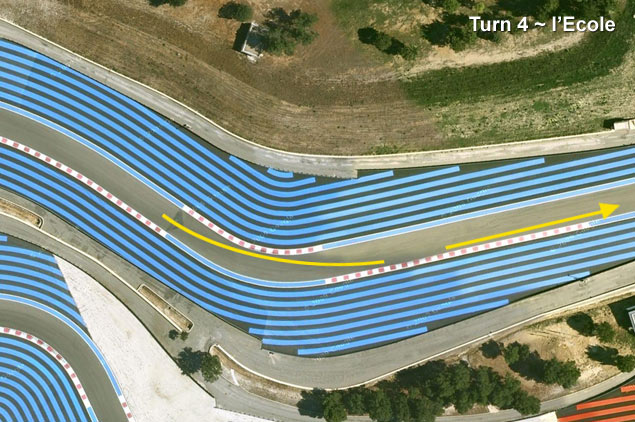
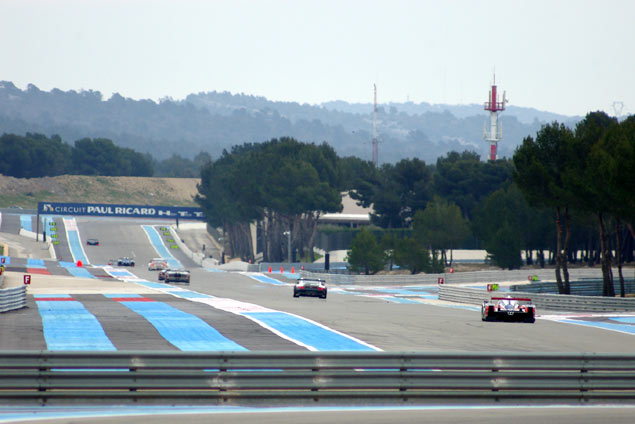
At
1.8 kilometres, the Mistral (above)
is one of the longest straights in motorsport,
and when the chicanes aren’t in use,
it’s probably the only place where drivers
can experience the kind of straight-line speed
they’ll encounter along the Mulsanne
at Le Mans. For that reason, Paul Ricard has
always been a popular testing circuit for
those hoping to triumph in the 24 Hours. It
ends with the fast, sweeping and daunting
Signes Curve, below.
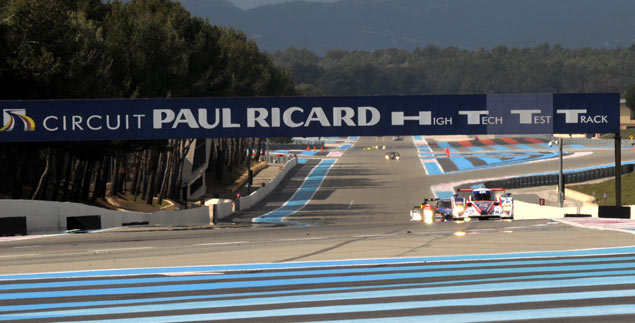
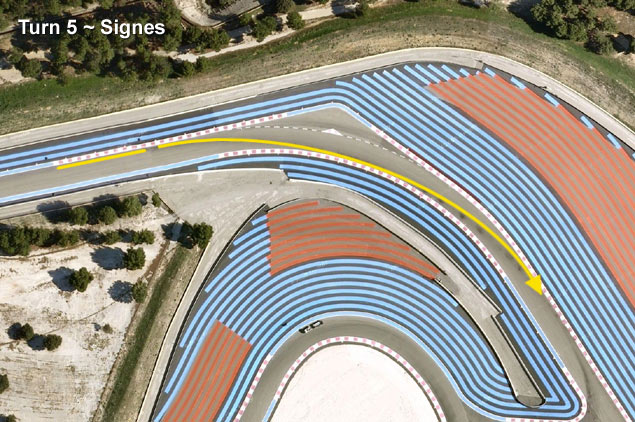
“Often
you can feel the strong mistral winds as you
momentarily relax along the straight. You
have to pick a path through the worst of the
bumps here too, so as not to bottom out the
car too much and scrub off speed. At close
to 300 km/h you arrive at Signes. Just a light
dab on the brake pedal, into fifth gear, then
turn-in and squeeze the throttle back down
as soon as you can. The speed and the downforce
are very impressive and you feel the g-force
build then ebb away as you reach the exit.”
The
speed that the cars carry through Signes is
such that the start of the double-right at
De Beausset arrives in little more than the
blink of an eye. The vast run-off beyond the
curve is testament to the risks that drivers
take as they aim to carry pace as far through
the corner as they dare, and there will be
few who don’t run wide here at least
once during a stint.
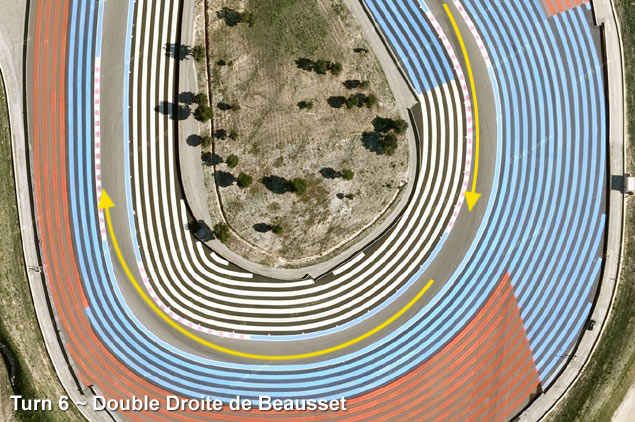
“Almost
immediately you arrive at the Double Right
(above). The entry is fast and the
road dips away. Then it tightens quite considerably
and the road rises again (below).
It’s a tricky corner to get right, and
in the Lola Coupé the right-hand roof
pillar obscures your view of the second apex.
You have to use other references to gauge
where you are.”
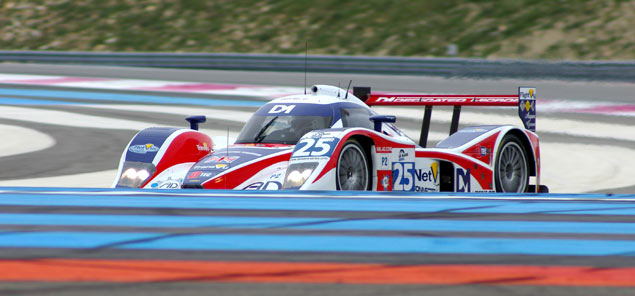
This
is the point where the cars enter the field
of view for those in the spectator enclosures,
and it is possible to track the cars through
corners 6, 7, 8 and 9, and back onto the start-finish
straight.
“Next
comes l’Epingle (the “Pin”,
Turn 7 below), a reducing radius left-hander
that seems to go on forever. You can carry
good speed into this second-gear corner but
as it tightens, you again lose sight of the
apex and have to use alternative landmarks
to reach it. Back to full throttle and up
through the gear around the gentle right-hand
curve at Village (Turn 8 below).”
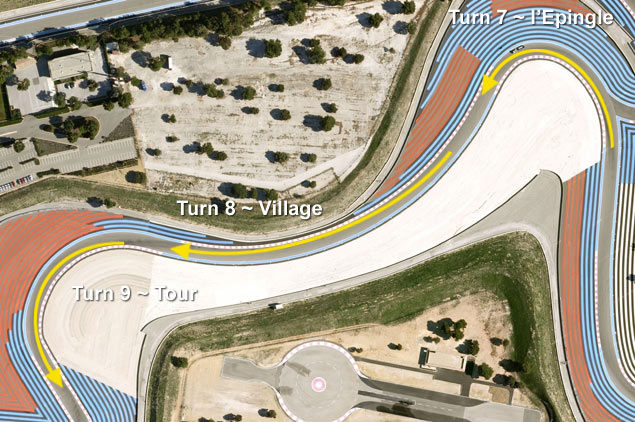
It
will be interesting to view the start from
a vantage point somewhere near here, as the
cars process through the final corners, jostling
for position behind the pace car. When that
dives towards the infield just beyond the
final turn, that will be the signal for the
pole-setter to control the final few seconds,
and then unleash those tens of thousands of
amassed horsepower as the race roars into
life.
“Turn
9, Tour (above), arrives suddenly,
and you have to brake diagonally in towards
the apex in order to slow the car enough to
make the corner. Then a short step on the
throttle in second gear takes you to the final
turn, Virage du Pont (below).”
“This
is a very tight first gear right hander that
leads you back onto the pit straight. The
traction control works overtime on the exit
as the tyres scrabble for grip. As you sweep
across the line the lap time flashes up on
the dash and you speed into another lap!”

Andy
has some fond memories of his laps of Paul
Ricard. “I first drove at Paul Ricard
in early 1988, during my audition for a place
on TWR Jaguar’s Le Mans squad. It was
also the first time I had driven at over 200
mph, and was a real eye opener. I got the
drive, so I think I did OK!”
Back
in 1988 the circuit was at the height of its
fame and still the venue for the French Grand
Prix, but in pre-HTTT configuration. “Of
course the circuit has changed a lot since
then, but it still follows the same general
layout. Safety has been improved beyond all
recognition and the paddock facilities are
truly amazing. Everything about the circuit
is first class and it’s an excellent
place go testing in preparation for Le Mans.
I haven’t raced at Paul Ricard since
my David Price Racing Harrods McLaren days
in 1996, but have been lucky enough to test
there on numerous occasions. I’m really
looking forward to the 8 hour Le Mans Series
event driving the RML AD Group Lola Coupe
HPD with Tommy Erdos & Mike Newton.”
The
Paul Ricard 8 Hour will be the longest race
yet staged under the Le Mans Series banner,
and has attracted a bumper entry for the first
race of 2010. The line-up in LMP2 includes
the current holders of the LMP2 title, at
least four previous class-winners, and newcomers
to the category, Strakka Racing, who set fastest
time in LMP2 during last month’s official
test. It looks set to be a hotly contested
class.
The
Class of 2010
The
full entry list for LMP2 is reproduced below.
For medium resolution images of all cars,
please see the All
Teams Gallery:
A
Plan of the
Circuit
The
plan of the circuit below shows the principal
corners and the configuration to be used for
the Le Mans Series test. This will include
the whole uninterrupted length of the Mistral
Straight. Clicking the image below will access
a full circuit plan (in black and white) at
high resolution. If you would prefer this
as an EPS file, please request
that we email you a copy. Any use elsewhere
must be acknowledged. This plan includes the
revised pitlane exit and new garage section,
which is expected to be completed in time
for the Paul Ricard 8 Hours and will enable
the full grid of cars to be accommodated.

The
same view from Google Earth . . .

Click
on the image above for a higher resolution
image, or use this link to access the Google
Earth location directly.
Weekend
Schedule
The
following schedule is subject to change
and the circumstances and events of the
day